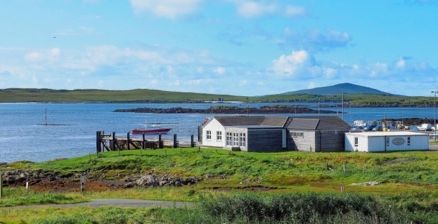16. Middle of somewhere

The Hidden Meaning Behind our Logo
Sometimes one sentence can capture a thought that would take a whole blog to convey! Recently I came across a lovely typography print on Etsy that really sums up my feelings about where we call home.
“Some call it the middle of nowhere, we call it the centre of everything”.
The Outer Hebrides are often described as remote or more theatrically “islands on the edge”. There is still a romantic misconception that we are are on the fringes of civilisation, miles from modern amenities and a step back in time. Visitors are often amazed that our kids catch two buses for the one hour journey to school, or that we drive for almost two hours to get to the nearest Tesco. But we are very proud of where we live and defensive of any suggestion that the island is a sleepy backwater - (Remember the outcry when BBC weatherman Tomasz Schafernaker called the Outer Hebrides “Nowheresville”) Far from feeling like we are in the “middle of nowhere” our little patch of South Harris is the centre of our world.
Adapting to a different pace
Last week we were asked to record a piece for a BBC programme talking about our experience of moving to the Outer Hebrides and it has really made me think back to our old life and how we have adjusted to the pace of life in Harris. What we have found is that many of the perceived inconveniences of living in a remote rural community have now become, not only the norm for us, but actually advantages. Where we lived in Oxfordshire could have been described as “out in the sticks”. Although we lived in a small village surrounded by farmland, we were really well connected to several large towns and cities. Within ten miles there were about ten large supermarkets. We had a choice of any restaurant or takeaway you could imagine. DIY stores, clothes shops, book shops; there wasn’t just one of any these shops near where we lived we had a choice. We could see a band, a film, go to the theatre or even ice skating whenever we wanted and probably because we could do these things "anytime" we did them very rarely.
Looking back, although we tried hard to resist it, our old life was much more driven by materialism, keeping up with the Jones' and having what we wanted the moment we thought of it. When we first moved here we would go to the mainland often to get some of the bright lights we were missing. In the first few years of living here an off island trip always involved eating at as many fast food places as possible, and shopping til we dropped. Having now lived in Harris for seven and a half years we think that one of the greatest things about living in Harris is that nobody judges you on the size of your house, the age of your car or the amount of money you earn.
Good things are worth the wait
There is no denying that we do live in a rural area. Here in Borrisdale we are 25 miles from Tarbert which is the largest settlement in Harris and 57 miles from Stornoway the only town in the Outer Hebrides. To pick up a Chinese takeaway we would have a 114 mile round trip! We can get almost anything we want but sometimes we have to be patient. Newspapers arrive by plane (subject to weather!) and make it to the shops mid afternoon - the Sunday papers are only available on a Monday afternoon! This is often a source of great amusement for visitors but to us its just life on an island. An example of the advantages of delayed gratification on Harris is the much anticipated visit of the "Screen Machine". This is an 80 seat mobile cinema in the back of an articulated lorry that comes to Tarbert once every few months with a programme of films for all ages. Tickets are very much in demand and the school kids all go to see the latest films together. On the mainland I remember going to see a film as a couple and as a family but never as a community.

Everything we need and more
Here in Borrisdale we don't have shops or restaurants or any other amenities (except the fank!) however, we consider ourselves very lucky to live just a couple of miles from Leverburgh which is home to some of the best small independent businesses on the island. During the week I work in a community owned shop called Co-Chomunn na Hearradh or An Clachan. We sell everything from a pint of milk to a lump hammer. There is also also a 24 hour fuel station. From the pier the Calmac vessel Loch Portain takes a winding path through the sand banks and rocks in the sound of Harris three times a day taking local people, produce and visitors to the islands further south in the Hebridean chain. This is a busy route and a lifeline to many local people and businesses. It also brings around 54,000 people a year to Harris making Leverburgh one of the most important routes of entry to the "Long Island". Next to Leverburgh Pier is the Anchorage restaurant and bar and Shonnie’s garage where you can get your car fixed and buy a sack of logs or compost or chicken feed!

By Anne Burgess, CC BY-SA 2.0, https://commons.wikimedia.org/w/index.php?curid=14072619
Joan’s hairdressers, Temple Deli, the Mustard Shack and Borrisdale Tweed (run by our weaving neighbours) all serve the community and visitors to the island from the village and very soon we will also have a coffee roastery and a smokehouse in the village! Four wheeled facilities include the famous Butty Bus, the mobile Post Office and Gus’ mobile shop. Leverburgh also boasts a small primary school, a doctor’s surgery, a laundrette, a fire station, a busy working fishing pier and three churches. From this spot at the far Southern end of the island we have just about everything we could ever want or need.
When we started the brewery we knew we wanted Harris and in particular Borrisdale to be at the centre of our story. So, we chose the name Isle of Harris Brewery and designed our logo with Borrisdale right in the middle of the image. Every bottle, beermat or flyer comes with the hidden message that this great place isn’t the middle of nowhere its the centre of everything.

So to anyone in any doubt we can confidently say this little brewery is right in the middle of somewhere very special.








